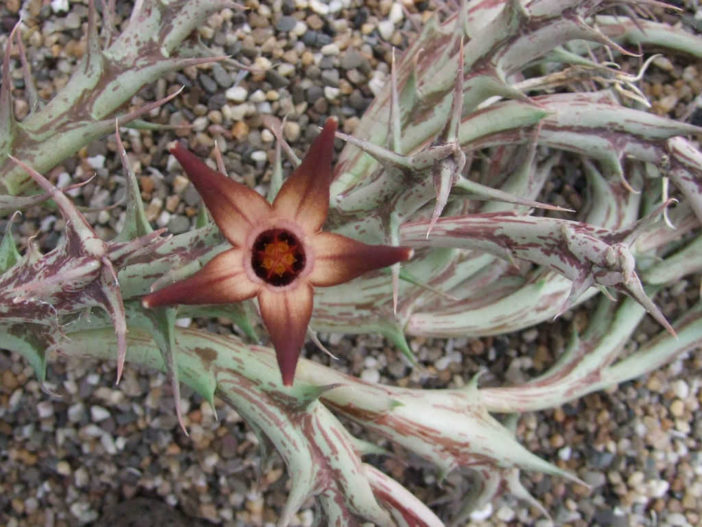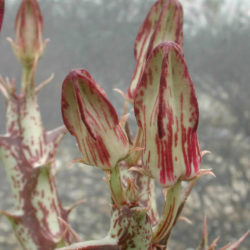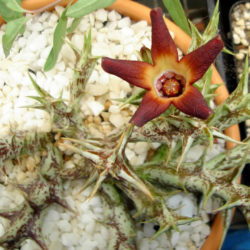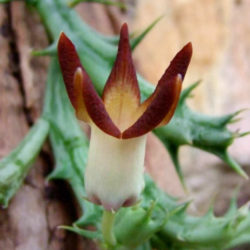Scientific Name
Orbea distincta (E.A. Bruce) Bruyns
Synonym(s)
Angolluma distincta, Caralluma distincta, Ceropegia distinctantha, Pachycymbium distinctum
Scientific Classification
Family: Apocynaceae
Subfamily: Asclepiadoideae
Tribe: Ceropegieae
Subtribe: Stapeliinae
Genus: Orbea
Description
Orbea distincta is a succulent plant with trailing, branched stems with tubercles arranged into four rows along the stem with a slight groove between rows, tapering into a long, slender, conical spreading tooth. The stems are cylindrical in cross-section and 0.3 inches (0.8 cm) in diameter (excluding teeth). They are pale green to grey-green mottled with dark green to purple-brown.
During the fall, the plant produces attractive, erect, usually bicolored flowers near the tips of the stems. The flowers are bell-shaped with a tube measuring up to 0.7 inches (1.7 cm) long and 0.4 inches (1 cm) in diameter and five erect or spreading corolla lobes measuring up to 0.6 inches (1.5 cm) long and 0.4 inches (1 cm) wide. The corolla lobes are carmine to brown, fading to pale creamy-yellow within the tube.
Origin
Orbea distincta is native to northeastern Tanzania and southern Kenya. It grows in white or greyish sand, usually among short grasses at elevations that range from 100 to 3,940 feet (30 to 1,200 m).

Hardiness
USDA hardiness zone 9b to 11b: from 25 °F (−3.9 °C) to 50 °F (+10 °C).
How to Grow and Care
Several species are pretty easy to grow. Others, often those with slightly hairy stems and the more unusual flowers, are more challenging and require careful watering (with some fertilizer) during the growing season and complete water withdrawal during the winter months. A minimum winter temperature of 10°C (50°F) is acceptable, providing that soil is kept dry. A heated growing bench or incubator may help delicate plants get through the colder months. However, many species live under shrubs in their habitat and prefer light shade rather than full sun.
A gritty compost is essential, and clay pots are advisable for the more delicate species. Some growers prefer mineral-only compost to minimize the chance of a fungal attack on the roots. A layer of grit on the compost surface prevents moisture from accumulating around the base of the stems.
Keeping Stapelias and their roots free of pests such as mealybugs is the key to success, as fungal attack often occurs due to damage to stems by insects.
See more at How to Grow and Care for Stapelia.
Links
- Back to genus Orbea
- Succupedia: Browse succulents by Scientific Name, Common Name, Genus, Family, USDA Hardiness Zone, Origin, or cacti by Genus
Photo Gallery
Click on a photo to see a larger version.



